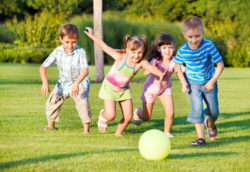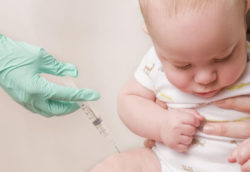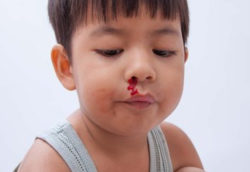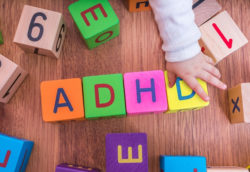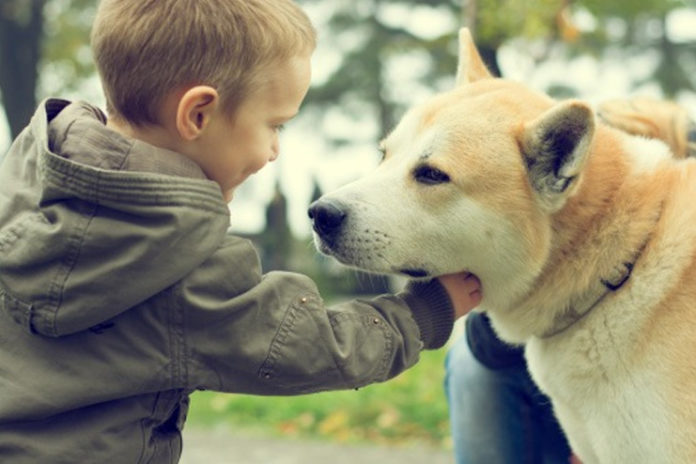Is your child ready for a pet? Petting and playing with dogs is the most exciting activity for many kids. Most of the pets come with many advantages and disadvantages. Biting is one of the worst-case scenarios that the kids experience with dogs.
As per the study from the Center for Disease Control (CDC), it was recognized that 4.8 million dog bites occur each year. of the kids, more than half are under the age of 14.
This article discusses dog bites in kids. It presents first aid for dog bites and the tips to prevent dogs from biting.
Dog Bites in Children:
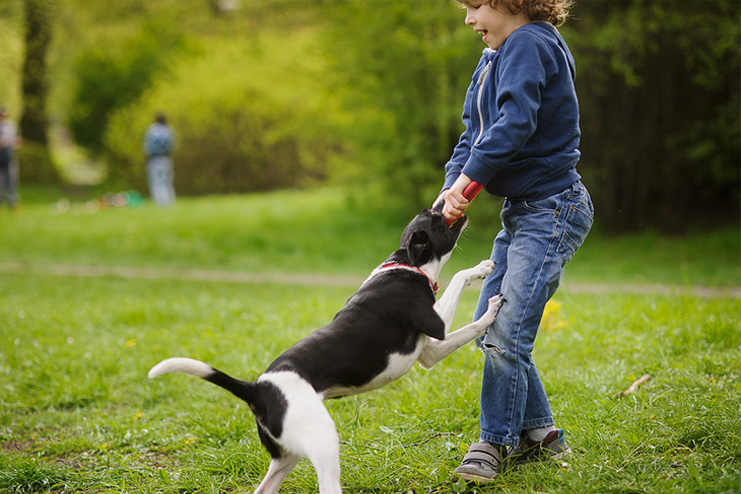
Dogs are considered as the human’s best friend and it is innate to think that your best friend does not bite you. But, it is too important to remember that the dogs lash out of the feeling of being threatened or when they are excited. With the lack of awareness to handle the pets, kids are more vulnerable to dog bites.
Pros and Cons of Having a Pet:
Getting a pet home is not an easy decision. A lot of patience and time is required to understand and train pets. After taking into account all the consequences, inviting the pet into the home has both positives and negatives.
Pros:
1. Increases personal safety:
Dogs can bring some degree of safety to life. They provide safety on the night walks and keep their owners alert to reaching the dangers like fire or gas.
2. Children can attach to a new pet:
Children can build emotional support quickly with their pets which can bring them support and conditional love. Children learn to communicate with their pets over time. Children get to demonstrate their patience and problem solving skills while encouraging pets to cooperate. Children feel free to reveal their secrets and receive some emotional support in the form of kisses and other forms of affection.
3. Family pets are the great way to teach your kids the responsibility:
Responsibility can be introduced to the kids by incorporating some age specific activities in their daily routine. Assigning the caregiving task of the pets fosters their quality of being responsible. Petting can teach them many healthy habits like walking. They come to realize that walking with dog is not just the playtime but a vital part of keeping their dog healthy. Younger kids need proper guidance and support from their parents but, older kids can achieve successful ownership without any guidance.
4. Makes the mind calm and peace:
The act of petting boosts the production of oxytocin, a hormone that makes you feel less stressed. Interacting with the family pet is the best stress coping mechanism.
Cons:
1. Allergies:
Allergies and certain medical conditions of the kids may make growing a pet more challenging. Some studies state that having a pet from an early ages may make kids less prone to pet allergies. Some other studies state that the kids who have dogs have better resistance to respiratory infection when compared to the resistance of the kids who do not have pets.
2. It requires huge commitment from the family:
The pets are not the perfect family addition for the families that have busy schedules. Children will require complete knowledge of the things and toys that should be kept out of their pet’s reach. Having a pet requires long term commitment and the family should ensure that their pets attain proper personal and health care throughout their life span.
3. Have to encounter certain amount of risk:
Studies show that children are the most common victims of the bites by the family pets. Among the millions of Americans that encounter dog bites, one out of five bites can cause injury and require immediate medical attention.
Why Do Dogs Bite?
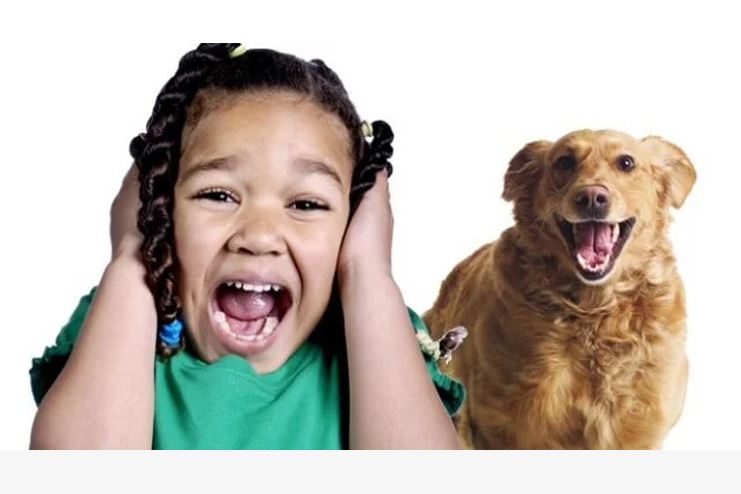
Irrespective of the gender and breed any dog can bite when provoked. Dogs usually bite in response to aggressive behavior.
Here are a few other reasons for dog bites in children:
1. In response to some negative triggers:
Dogs bite in response to something. If the dogs are left in a stressful situation, they fight to defend its self and its territory.
Dogs bite when they are scared or startled. They tend to bite when they are frightened or they find themselves in the threatening state. They also bite to protect something that they feel valuable to them like their puppies, food, or toy.
2. Startling a dog is not good:
Waking them from the sleep or reaching them from the behind may put them in a sudden shock. The startled responses may stimulate them to bite.
Poking, pulling its fur, ears, and tail may startle the dog proving them to bite.
3. Making the dog over excited:
Engaging the dog into the rough play may make it get over excited. Dogs tend to nip by putting something in their mouth when they are excited. Dogs know that your hands and legs move the fastest when they are nipped. An adult know how to control the dog from the nipping. But younger kids might not be aware of this and may end up with the injuries.
4. Dogs bite when they are not feeling well:
Dogs tend to bite when they are not feeling well. Injuries or illness may put them into the feeling of sickness or soreness which make them demand the episodes of loneliness.
5. Dogs may bite in fun:
Dogs may tend to nip and bite kids while playing. This may be fun for the dogs but may be dangerous. It’s not a good idea to play wrestling or tug of war with the dog. These activities make the dog over excited and stimulative to bite.
Running away from the dog during the play may also induce the similar response in the dog. Running away may initiate the herding behavior in some breeds. Dogs may see the kids as the prey while they are running.
6. Dogs might bite under the fearful situations:
A dog which is in the fearful situation might bite anyone that approaches them. Such situation may seem to be abused or abandoned by the side of the road.
What To Do After Dog Bite In Children?
First aid treatment is necessary when the dogs bite the children. First aid is the vital treatment for dog bite in child. If there are no visible marks, tearing or punctures in the affected area of your kid, it is not necessary to visit the doctor. It is recommended to visit the doctor after the first aid to ensure that there are no side effects.
In some cases, self-first aid can be administered easily and some other cases require immediate medical attention. Here the steps to follow during for the first aid after the dog bite in kid:
STEP 1: Control Bleeding
Just like any other bleeding that occur during the normal injury, it is essential to control the bleeding as much as possible. Use a clean or washed cloth to put pressure on the injury and make it to stop. Elevate the injured area in case of severe bleeding.
STEP 2: Clean the affected area
Wash the area of bite or scratch with soap and water. Hold the affected area under the running water to wash away the bacteria.
STEP 3: Cover the affected area
Gently pat the affected area to dry. Put some antibiotic ointment on the affected area and cover it up with the bandage.
The above first aid treatment is same for the both minor and deep wounds.
If your dog bite someone, it is more important to act out quickly. Assist the victim by confining your dog. Take the victim to the hospital after washing the bite thoroughly with the soap and warm water.
Possible Complications Of The Dog Bite:
Dog bites can cause many other severe complications. The complications might be infections, rabies, nerve, or muscle damage and more:
1. Infections:
Infections may result from the bacteria living in the dog’s mouth. Here are a few bacterial infections:
• Staphylococcus
• Pasteurella
• Capnocytophaga
2. Nerve and muscle damage:
Muscles, nerves, and blood vessels may be damaged by the deep bite. This condition takes place even when the wound appears to be small and like a punctured marks.
3. Broken bones:
A bit from the large dog may result in the broken or fractured especially in the legs, feet, or hands. Consult your doctor, if you notice any kind of breaks in the bones.
4. Rabies:
It is a serious viral conditions that shows effect on the central nervous system. It may lead to death if left untreated for many days after the infection. Seek the immediate medical attention, if you feel the dog that you have been bitten is not given the rabies vaccination.
5. Tetanus:
Tetanus is a bacterial disease that occurs due to the dog bite. It is uncommon the US children as they are given the vaccination regularly. Tetanus booster shot is given to the adults for every 10 years.
6. Scarring:
Scarring occurs if the dog bite tears the skin. Mild scarring may lessen over the time.
Medical techniques like grafting or plastic surgery will help to eliminate the scars on the visible areas like face.
7. Deaths:
The number of deaths resulting from the dog bites in the children is very low. When they occur, about 70 percent of the deaths of the dog bites may occur in the children younger than 10 years old.
Treatment For The Dog Bites In Children:
In addition to the irrigation and cleansing post the dog biting, kids with severe injuries require further evaluation and treatment. Here is the procedure for dog bite treatment in children.
• Kids with deep cuts or lacerations require stitches. Wounds that are at the higher risk of infection or the wounds that are older than 12 hours or kept open to give them space to heal on their own. These unrepaired wounds need the follow up with a plastic surgeon to discuss the wound healing.
• X-ray and surgical consult are required for the children with the injuries that involve bones, joints, and tendons. A child with the complex injuries needs surgery to repair their wounds.
To prevent the infection, children with the weak immune system, poor wound healing capability will have to receive the oral antibiotics for 3-5 days. As the deep wounds are at the risk of tetanus infection, it is required to give the tetanus injection to the children, if they have not received at least 3 tetanus injections or have not received the tetanus injection in the preceding 5 years.
How to Prevent Dog Bites In Children?
Here are a few ways to prevent dog bites in children.
1. Check the history of the dog before getting home:
Talk to the professional about the type and the breed of the dog that is best for the household. It is more important to know about the dog’s temperament and the health. A dog that has the history of the aggression is not suitable as a pet for home and to live with the kids. Though the dog was not aggressive, hostile or the reactive depends on the way it was raised.
Studies show that mixed breed dogs and pit bulls are the highest responsible dogs for the most of the percentage of the recorded bites. Additional factors to consider are the head shape and weight. Studies found that dogs with Short and Wide heads weighing between 66 and 100 pounds are more likely to bite.
2. Ensure that immunizations are done:
if your family has a dog ensure that it gets all the required immunizations and the veterinary check ups. Make it a mandatory to spay or neuter the dog. To make your pet more social and obedient, allow it get trained from the obedience school. A well trained and obedient dog is less likely to bite.
3. Always keep an eye on your pet:
While taking the dog out to some public space, keep it under your control by putting it on a leash so that it is easy for you to control when the situation goes out of hand. Ensure that your kids should play with the pets only under the supervision.
If you notice any kind of fearful or aggressive tendencies, warn the others. Don’t allow your pet to approach people and the other animals unless the situation is strictly controlled.
4. Teach your kids certain precautions:
Brainstorm your kids on certain things that they should not do when they with the dogs. Here are the following:
• Tell your kid not squeeze dogs too tight, drop them, fall on them, and jump on them.
• Never tease them by pulling the tail and ears.
• Never try to irritate them while they are eating, sleeping, and taking care of their puppies.
• It is not good to take away bone or toy away from the dog or play tug of war with it.
• Ask them not to give a dog treat with their fingers. Teach them to put the treat in the palm with the fingers and the thumb held close together.
5. Let it come across various situations:
Make your dog to expose regularly to various kinds of situations like other dogs, loud noises, large machine, bicycle, or anything else that may trigger the fear. It is better to start training your dog at the younger age to turn the negatives to positives.
6. Handle your dog gently:
Don’t try to discipline your dog by using the harsh physical, or violent punishments. Use the praise and treat model before turning to the aversives, such as shock collars, and loud noises in the process of disciplining the undesirable behaviors. The good idea is to reward the dog when it was met with some desirable behavior because dogs always aim to please their people.
The technique of positive reinforcement works well with the dogs which is the phenomenon of praising the dog for the appropriate behavior instead of punishing them for the undesirable behavior. Treats, extra playtime, verbal encouragement, petting, or any other activity that the dogs enjoy come under the positive reinforcement.
7. Keep your dog in sight always:
Ensure to keep your dog on a leash or in a fenced area. Make sure that your dog is well before letting it off the leash into the permitted area. Don’t allow your dog to run out of your sight.
8. Work on obedience training:
It is easy to control an obedient dog. By using the obedient training, you could be able to use the basic commands to make the dog stay focused on you when it is in an uncomfortable situation. The dogs which can be well controlled by their trainer are less likely to bite. Training will help to give some structure and boost its confidence.
9. Be aware of your dog’s body language:
Dogs use the body language to communicate with their owner. Pay attention to what their body language is telling you. A dog that is concerned about its territory being invaded is at the risk of biting. Some of the uncomfortable cues that the dogs display are bared teeth, raised hackles, a lowered head, or ears lying flat against the head. If you notice these kinds of cues in your dog give it some space, leave it alone and advise others to stay away from it.
10. Don’t stop a dog’s growls:
Dogs growl to make you aware that they are uncomfortable with the person or the situation. It is a signal that it may bite. Stopping the dog from the growling means you are preventing them to communicate. The best thing you can do is to pay attention to the circumstances that keep your dog in the uncomfortable situation. Once you diagnose the reasons, you can start the dog training program to help your dog become more comfortable with those situations. Once your dog is comfortable, it won’t require the need to grawl.
Common Dog Safety Myths:
Lack of knowledge of the safety practices is prevailing among both the parents and the dog owners. Here are a few common myths about the dogs and the children:
Myth 1: Dogs socialized to children as puppies will not bite them
Dogs that are socialized to the kids as puppies make a great attachment with the kids more than the exposure to children. If the socialization is applied more carefully, the puppies feel safe all the time.
Myth 2: a dog which is safe with the adults also safe with the children
To many dogs, newborns, babies, toddlers, preschoolers work the different way than the adults. They are different in the sizes and the behavior. They move, act, sound differently than adults.
Myth 3: children who discipline the child are likely to get control over them
A child who is successful in discipling a child are likely to receive the defensive actions from their dog towards any kind of threat.
Myth 4: Kids who knows the gentle treatment are unlikely to get dog bites
If the kids try to approach the dogs despite the early indications of the stress, a bite may occur.
Myth 5: Dogs that kiss the kids and wag their tails do not bite them
Dogs that learn to show the affection towards your kid do not bite your child. They are likely to get into the aggressive actions if they are kissed or hugged by the strangers sometimes. putting the face closer to the dogs might not be safe especially when the dog is uncomfortable.
When To See A Doctor For Dog Bites In Children?
The following are some of the conditions for which the doctor visit is mandatory:
• If the wounds are very deep and are on the child’s face.
• If the bleeding is not controlled after the 10 minutes of applying the direct pressure
• Your child has redness, swelling, pain, or irritation in the affected area.
• If you are unsure of the medical track of the dog.
• If the skin is punctured, it may be sensitive to the bacterial infections and should be treated immediately.
In conclusion, assisting your child while playing with the dog will help them prevent dog bites. In case your child is the victim of dog bite, do not panic. Administer the first aid and taking them to the hospital for the further evaluation are the good things you can do to save them from the danger.












